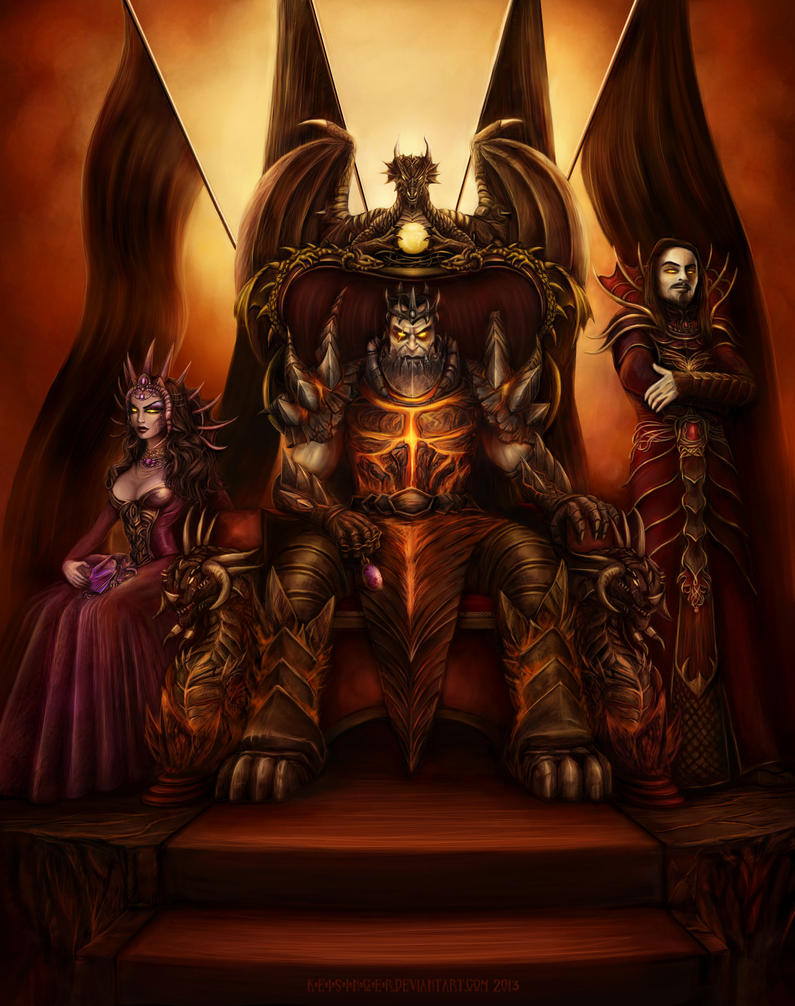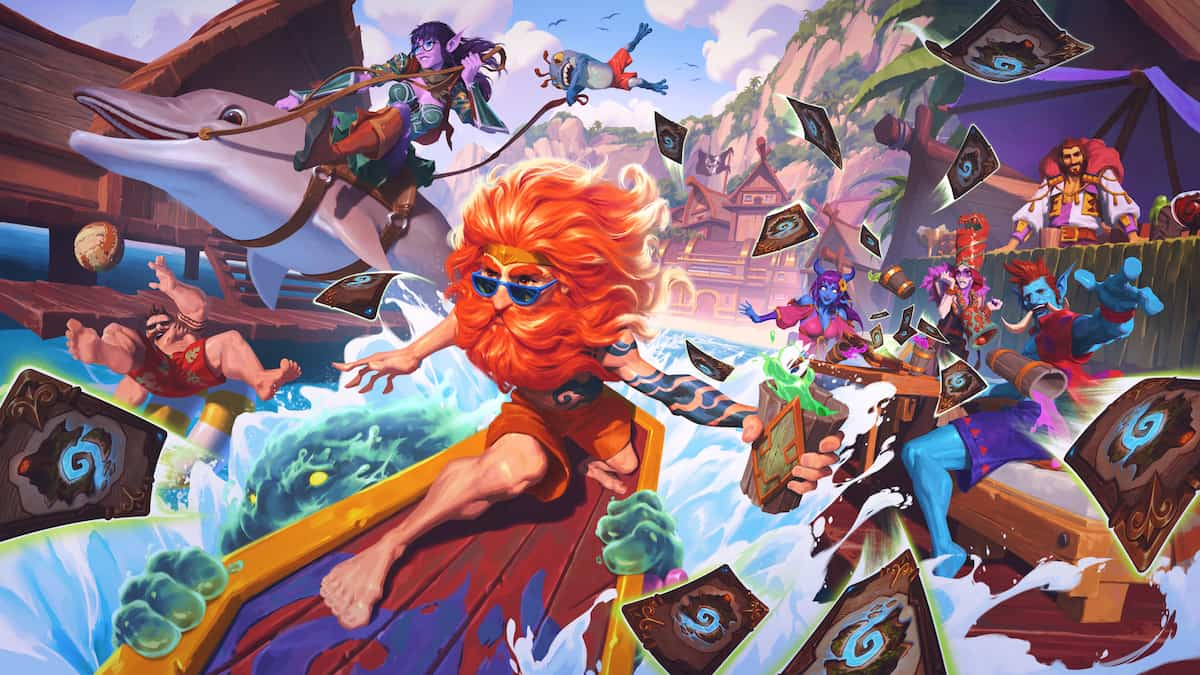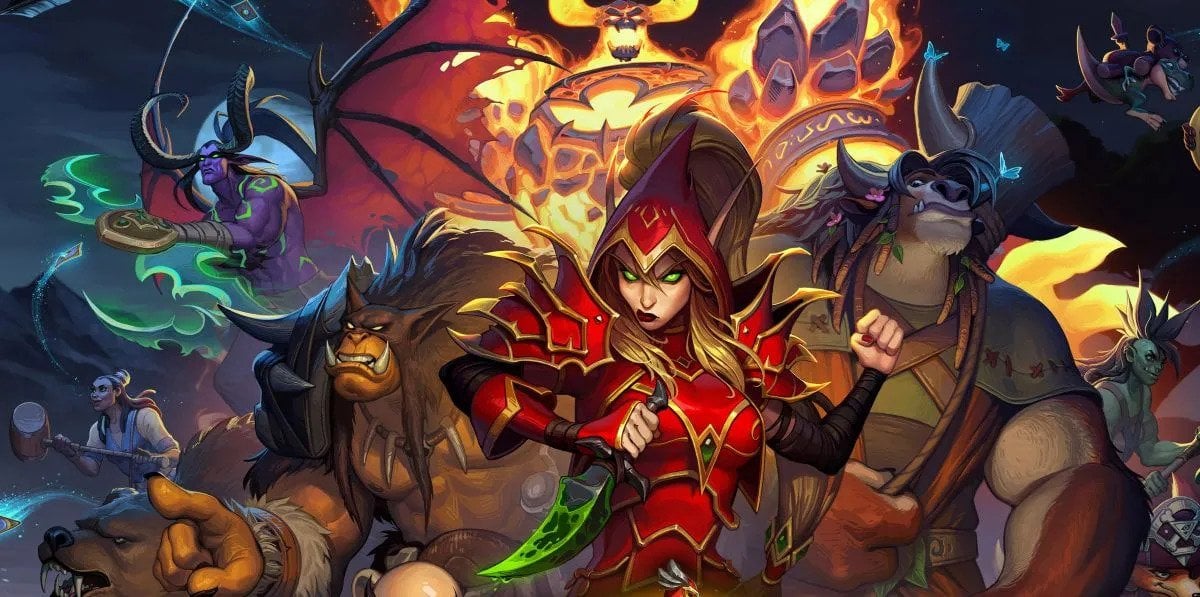Hello and welcome to yet another Flavor Text and Lore article. Stay a while… And read about the story and lore behind the second part of Hearthstone’s largest adventure, the upper part of Blackrock Mountain… Blackrock Spire!
The previous article took us on a trip to Azeroth’s ancient history and the forming of the great mountain itself. While most of the early adventures described were to be found above sea level, the rest of the mountain remains to explore – the area above sea level is most commonly known as “Blackrock Spire”, and it is the place where first the orcs, and then the Black Dragonflight, would make their last stand…
Climbing the Spire
Once upon a time, when reaching World of Warcraft’s maximum character level, before the first expansion, one dungeon stood as the pinnacle of challenge for small groups. That dungeon was Blackrock Spire, and was so massive that it had to be divided into two parts: Lower and Upper.

The Lower Blackrock Spire was inhabited by the remnants of the original Horde, now called “the Dark Horde” by their enemies, and “the True Horde” by themselves. Particularly, this network of caverns bridged by stone and wood structures was home to the few remaining clans of Ogres that had not split from the Horde after the Second War portrayed in Warcraft II.
It was a tricky dungeon to navigate, with some challenging bosses, but it was mostly reviled for having little loot of interest but being required all the same to earn the pieces that would be used to assemble the key to grant access to the real challenge: Upper Blackrock Spire, its entrance sealed and openable only via the aforementioned key (a magical ring) or by recruiting the services of a Rogue skilled at lock picking, or a Master Engineer that could blow up the lock.
Incidentally, keybearers or locksmiths made quite a killing in this department, often being paid to simply get in the raid and unlock the door so that other players could access the Upper dungeon without having to go through the trouble of crafting the key. Yours truly amassed quite a bit of gold just like that.

Once inside the Upper Blackrock spire, all bets were off. It was filled with loot but notoriously difficult – and due to that, the most usual approach was to attack it with a team of ten players instead of the standard five – and would mercilessly punish any sloppiness, sometimes hilariously so, as we can attest via the legend of Leeroy Jenkins.
But what’s the story behind this deathtrap? Well, the player would initially storm it as part of a campaign to cull the Dark Horde from existence, but it soon becomes obvious that there is a far darker power behind the orcish remnants.
At a particularly memorable juncture, the players are herded into the bottom of an arena, where they must vanquish increasingly though waves of enemies while spectated by the leader of the Dark Horde, rend-blackhand son of Blackhand, who was warchief of the Horde before being defeated by Orgrim Doomhammer.

But as the players emerge victorious, it becomes increasingly noticeable that Rend is in fact subservient to the human-like being accompanying him, Lord Victor Nefarius (I know, not a suspicious name at all), who ultimately commands Rend to attack the players, a command that the warchief gleefully obeys.
Unlike in the Hearthstone adventure, it’s only after this gauntlet that the players get to face the ultimate master of the Upper Blackrock Spire, Nefarius’ lieutenant, General Drakkisath. This dragonkin boss was considered the toughest non-raid boss in the game, but many questions were left unanswered after his defeat…
The True Lord of the Spire
Back in the heyday of the Second War, the Black Dragonflight patriarch deathwing struck a deal with the Horde, traveling to Draenor in order to hide his eggs away from the prying eyes of the other dragonflights, who he knew would destroy them on sight, as to prevent him from weaponizing his brood.

At the same time, he managed to help the Horde enslave his greatest enemy, the red matriarch alexstrasza, and in his human guise, tried to destroy the alliance from within. His plans, however, were shattered by the meddling of the human mage rhonin and his companion Vereesa Windrunner, who freed Alexstrasza and enabled the other dragon lords, malygos, nozdormu and ysera , to strike at their estranged brother. deathwing was forced to flee from Azeroth and into the elemental plane of Earth, to recuperate.
But unbeknownst to his enemies, he left his two eldest children behind, to carry on his work – nefarian and onyxia.
While onyxia concerned herself with crippling the Alliance’s core by manipulating Stormwind via the ensorcellment of king varian-wrynn (a tale told in a previous article), nefarian was charged with growing his army, not only by proliferating the Black brood, but also by experimenting with eggs of the other dragonflights in order to create living weapons – the Chromatic Dragonflight.

And Blackrock Spire was the seat from where nefarian decided to build his army, after the original Horde had been broken, and the lands seemingly abandoned. But he found a powerful foe beneath the mountain – ragnaros-the-firelord and skirmishes between their forces became frequent. Still, the experiments, and the building of his army, continued undeterred.
The Blackwing Lair was one of the original World of Warcraft’s most memorable raids, having been made available a few months after launch, and aimed at players that had braved the Molten Core and were equipped with the powerful gear found within.
Once more, forty players were a near-requirement to be able to face the challenges of the Lair, and Blizzard’s designers went out of their way to populate the dungeon with memorable, unique encounters – some of which transitioned to the Hearthstone Adventure beautifully.

Razorgore, as an example, needs to be mind-controlled by the players and used to destroy the dragon eggs before the raid is overwhelmed by whelps; Vaelastrasz, in the meantime – once alexstrasza’s consort, now corrupted and enslaved by nefarian – actually helps the players in defeating him, radiating his life-giving aura in order to increase their power so they can finish him before the corruption takes hold completely. And chromaggus is an abomination made by the combined blood of all the Dragonflights, and accordingly, can afflict the players with the powers of all five.
But few raid bosses strike a more imposing figure than Lord Victor Nefarius sitting atop his throne at the balcony that overlooks the Searing Gorge and the Burning Steppes. After a short conversation, he decrees that the games should begin, and battles for a few minutes in his human form, before taking on his true form – Blackwing, or nefarian, a huge black dragon that could turn player’s powers against their allies.
Once beaten, the players could then deliver nefarian’s head in Stormwind, where their victory would be announced for all to hear, and the head hung over the gates as a show of triumph. But even this was not the end of the Black Dragonflight…
The Blackwind Descent
So here’s where the story gets a bit muddled.
In the World of Warcraft storyline, the players kill nefarian and onyxia, and they stay dead for many, many years – up until the point when their father deathwing re-emerges from the elemental planes, triggering the Cataclysm.

At that time, the true lord of the Black Dragonflight assaults Stormwind and recovers the heads of his son and daughter, taking them to Blackrock Mountain, where he resurrects nefarian as an undead black dragon. nefarian in turn, resurrects his sister in much the same manner. He then sets out to restart his efforts in creating living weapons out of dragons.
However, in the Hearthstone Adventure, things don’t pan out like this. deathwing doesn’t figure in this storyline – instead, nefarian retreats further into his sanctum after his defeat, and players give chase, discovering his laboratory.
And this is fine, because to be honest, while there is much in terms of story to be gathered from lore books and quest text, the classic World of Warcraft dungeons and raids were very light on story, and often had none. Storytelling only became a thing in Massive Multiplayer Online Games much later.

So it’s natural that the Hearthstone adventure opted to be an adaptation of the original lore, over a strict retelling. It ends up being much more fun overall, and in this Adventure’s case in particular, they opted to use right from the start the much more vocal and witty version of nefarian that was introduced in the Cataclysm expansion, over the brooding and almost mute figure that the players faced in classic World of Warcraft. I guess that death lightened him up.
The Descent is just that: a laboratory embedded within the mountain (it’s a very big mountain – a lot of stuff fits inside) where rest several of the Black Dragonflight’s living weapons, and the stage for the final, epic battle against the black dragon siblings, complete with an arena that fills with molten lava and all.

Conclusion
In the end, as far as storytelling goes, the whole Blackrock Mountain package is much more compelling in Hearthstone than it ever was in World of Warcraft, and will likely stay that way, unless Blizzard takes the unlikely step of remaking all of the classic dungeons and raids. They did so with Upper Blackrock Spire, but that served a different narrative altogether.
It’s by the far the most complete Adventure, and arguably the most enjoyable. Certainly the one presenting the most fun, cohesive narrative, with the added bonus of exploring some of World of Warcraft’s oft forgotten classic locales. Here’s to hoping Blizzard will work on something similar once more.
I hope you enjoyed this trip into Warcraft lore. Please let me know in the comments if you liked it, and if I missed something!





Published: Feb 20, 2016 11:45 am